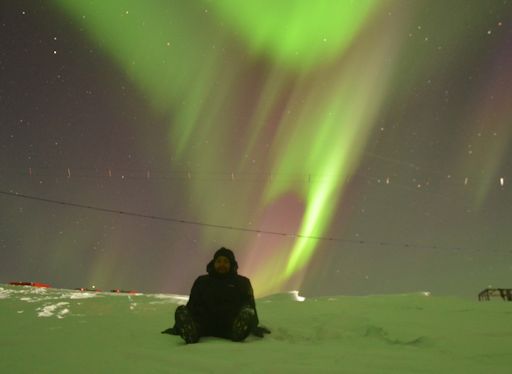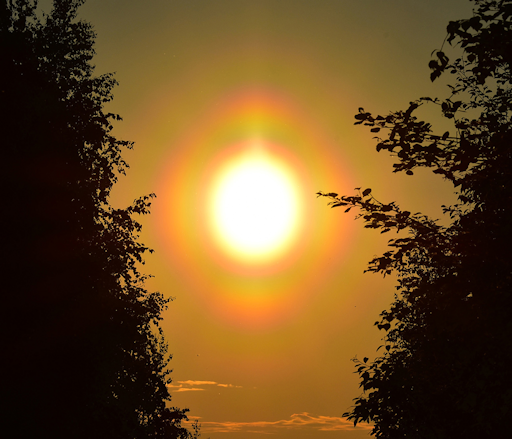It's waiting for you: The most successful Aurora Photo Tour on Earth! 100% success rate 4 years in a row and winner of the TripAdvisor Certificate of Excellence Award. Join LapplandMedia's aurora tours in Abisko, Swedish Lapland! | | |
THE MOTHER'S DAY STORM, PART 2? The strongest geomagnetic storm of 2016 happened almost one month ago, on May 8th (Mother's Day), when a solar wind stream hit Earth's magnetic field. During the G3-category event, auroras were photographed in the USA as far south as Kansas and Arkansas, and the entire landscape of Argentina's Belgrano II base in Antarctica turned green:

Is it about to happen again? The same stream of solar wind is returning. ETA: June 4th and 5th. NOAA analysts are forecasting a possible G2-class storm when the stream arrives. That's not as intense as the Mother's Day Storm, but still worth watching. High-latitude sky watchers should be alert for auroras, especially in the southern hemisphere where darkening autumn skies favor visibility. Aurora alerts: text, voice.
Realtime Aurora Photo Gallery
POLLEN CORONAS: It begins with a sneeze. Pollen floating through the air tickles your nose, and your body responds by expelling the allergen. Gesundheit! When the paroxysm subsides, look up at the sky. The same pollen that makes you sneeze can also make beautiful coronas around the sun, like this one photographed on June 1st by Vesa Vauhkonen of Rautalampi, Finland:

"Pine is strongly flowering now in middle Finland, and the coronas have been quite impressive over the past few days," says Vauhkonen. "Pollen is everywhere--not only in noses and eyes, but also around the setting sun."
Atmospheric optics expert Les Cowley explains the phenonenon: "Coronas are produced when light waves scatter from the outsides of small particles. Tiny droplets of water in clouds make most coronas, but opaque equal-sized pollen grains do even better. They make small but very colorful multi-ringed coronas."
"Unlike water droplets, pollens are non-spherical--and this adds to their magic," he continues. "Many have air sacs to help carry them in the wind. These align the grains to give beautiful elliptical coronas with bright spots." This is why Vauhkonen's pollen corona looks the way it does.
As northern spring turns into summer, pollen coronas become increasingly common. Look for them the next time your nose feels a tickle.
Realtime Space Weather Photo Gallery
SUPERIOR CONJUNCTION OF VENUS: Venus is about to pass directly behind the sun, an event astronomers call "superior conjunction." Coronagraphs onboard the Solar and Heliospheric Observatory (SOHO) are monitoring Venus as it disappears into the glare:

On June 7th, Venus will be at superior conjunction--a wonderful sight if only we could see it. Like the Moon, Venus has phases and on June 7th it will be gloriously full. The entire hemisphere facing Earth will be illuminated. Venus's acid-laced clouds are terrific reflectors and a full Venus would surely be visible in broad daylight, an intense pinprick of light in the blue sky.
Venus's passsage behind the sun marks an important transition. Earlier this year, Venus was a "morning star." After it emerges from behind the sun, it will become an "evening star" later in June, visible after sunset for the rest of northern summer. Stay tuned for Venuslight.
Realtime Space Weather Photo Gallery
SPACE BEARS MAKE GOOD GRADUATION GIFTS: Around the USA, high school seniors are preparing to receive their diplomas. Nothing says "you're on your way up!" better than a graduation gift from the Edge of Space. On May 25th, the students of Earth to Sky Calculus flew a family of "graduation grizzlies" 27 km (90,000 feet) above Earth's surface:

Outfitted with space helmets and a diploma, the intrepid Ursidae survived cosmic rays, ultra-low temperatures, and the near-vacuum of the stratosphere. For $49.95 you can have one of these bears along with a unique Graduation card showing the bears floating at the top of Earth's atmosphere. Buy one now.
Sales of the bears support student space weather research. In fact, the bears pictured above were hitchhiking on a payload equipped with radiation sensors. We send the sensors to the stratosphere every week to monitor increasing levels of cosmic rays. Visit the Earth to Sky store to support this crowd-funded research.
Realtime Sprite Photo Gallery
Realtime Noctilucent Cloud Photo Gallery
Realtime Comet Photo Gallery
Every night, a network of
NASA all-sky cameras scans the skies above the United States for meteoritic fireballs. Automated software maintained by NASA's Meteoroid Environment Office calculates their orbits, velocity, penetration depth in Earth's atmosphere and many other characteristics. Daily results are presented here on Spaceweather.com.
On Jun. 1, 2016, the network reported 22 fireballs.
(22 sporadics)

In this diagram of the inner solar system, all of the fireball orbits intersect at a single point--Earth. The orbits are color-coded by velocity, from slow (red) to fast (blue). [Larger image] [movies]
Potentially Hazardous Asteroids (
PHAs) are space rocks larger than approximately 100m that can come closer to Earth than 0.05 AU. None of the known PHAs is on a collision course with our planet, although astronomers are finding
new ones all the time.
On June 1, 2016 there were potentially hazardous asteroids.
Notes: LD means "Lunar Distance." 1 LD = 384,401 km, the distance between Earth and the Moon. 1 LD also equals 0.00256 AU. MAG is the visual magnitude of the asteroid on the date of closest approach. | | Cosmic Rays in the Atmosphere |
| Situation Report -- Oct. 30, 2015 | Stratospheric Radiation (+37o N) |
| Cosmic ray levels are elevated (+6.1% above the Space Age median). The trend is flat. Cosmic ray levels have increased +0% in the past month. |
| Sept. 06: 4.14 uSv/hr (414 uRad/hr) |
| Sept. 12: 4.09 uSv/hr (409 uRad/hr) |
| Sept. 23: 4.12 uSv/hr (412 uRad/hr) |
| Sept. 25: 4.16 uSv/hr (416 uRad/hr) |
| Sept. 27: 4.13 uSv/hr (413 uRad/hr) |
| Oct. 11: 4.02 uSv/hr (402 uRad/hr) |
| Oct. 22: 4.11 uSv/hr (411 uRad/hr) |
These measurements are based on regular space weather balloon flights: learn more. Approximately once a week, Spaceweather.com and the students of Earth to Sky Calculus fly "space weather balloons" to the stratosphere over California. These balloons are equipped with radiation sensors that detect cosmic rays, a surprisingly "down to Earth" form of space weather. Cosmic rays can seed clouds, trigger lightning, and penetrate commercial airplanes. Our measurements show that someone flying back and forth across the continental USA, just once, can absorb as much ionizing radiation as 2 to 5 dental X-rays. For example, here is the data from a flight on Oct. 22, 2015:

Radiation levels peak at the entrance to the stratosphere in a broad region called the "Pfotzer Maximum." This peak is named after physicist George Pfotzer who discovered it using balloons and Geiger tubes in the 1930s. Radiation levels there are more than 80x sea level.
Note that the bottom of the Pfotzer Maximim is near 55,000 ft. This means that some high-flying aircraft are not far from the zone of maximum radiation. Indeed, according to the Oct 22th measurements, a plane flying at 45,000 feet is exposed to 2.79 uSv/hr. At that rate, a passenger would absorb about one dental X-ray's worth of radiation in about 5 hours.
The radiation sensors onboard our helium balloons detect X-rays and gamma-rays in the energy range 10 keV to 20 MeV. These energies span the range of medical X-ray machines and airport security scanners.
| | The official U.S. government space weather bureau |
| | The first place to look for information about sundogs, pillars, rainbows and related phenomena. |
| | Researchers call it a "Hubble for the sun." SDO is the most advanced solar observatory ever. |
| | 3D views of the sun from NASA's Solar and Terrestrial Relations Observatory |
| | Realtime and archival images of the Sun from SOHO. |
| | from the NOAA Space Environment Center |
| | the underlying science of space weather |
 | Claim your tax refund with this UK tax rebate company and get back your overpaid tax. |
 | Enjoy this fabulous range of leather sofas from a leader in the UK sofa manufacturer industry.. |

